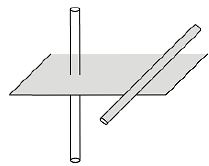Q.
Two mutually perpendicular infinitely long straight conductors carry in uniformly distributed charges of linear densities $\lambda _1$ and $\lambda _2$ are positioned at a distance $r$ from each other.
Force between the conductors depends on $r$ as
KVPYKVPY 2018Electric Charges and Fields
Solution:
Consider the arrangement given,

Force on a differentiable length element $\left(dl\right)$ of conductor $2$ due to field of conductor $1$ is
$dF = E_{1}dq$
where, $E_{1} =$ field of wire $1$ at location of $dl$
This force can be resolved into components $dF \cos \theta$ and $dF \sin \theta$ net force is sum of all $dF \cos \theta$ components, whereas $\Sigma dF \sin \theta = 0$ .
So, net force on conductor $2$ is
$F=\int dF=\int E_{1}dq$
Here, $E_{1}=\frac{2k\lambda_{1}}{R}=2k\lambda_{1}$
$dq=\lambda_{2}dl$
$\frac{l}{r} = \tan \theta$ and $\frac{r}{R}=\cos \theta$
$\Rightarrow dl=r \sec^{2}\theta d\theta$
Also, $\theta$ varies from $\frac{-\pi}{2}to\pi \frac{\pi}{2}$ for
conductor $2$.
so, $F=\int\limits_{-\pi /2}^{\pi /2}\frac{2k\lambda_{1}}{r \sec \theta}\cdot\lambda_{2}\cdot \,r \,\sec^{2}\theta \,d\theta$
$=2k\lambda_{1}\lambda_{2}\int\limits_{-\pi /2}^{\pi /2} \sec \theta d\theta$
$As\int\limits_{-\pi /2}^{\pi /2}\sec \theta d\theta =$ a constant
we can say that
$ F_{net}=C\cdot\lambda_{1} \lambda_{2} $ where $C=$ some constant
$\therefore F_{net \propto r^{o}}$
we can say that
$ F_{net}=C\cdot\lambda_{1} \lambda_{2} $ where $C=$ some constant
$\therefore F_{net \propto r^{o}}$